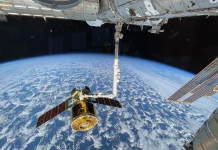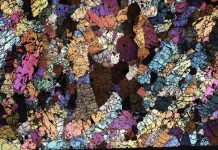Our moon is getting smaller, but how? And will the moon’s shrinkage impact NASA’s Artemis missions?
In a study published in The Planetary Science Journal, a team of scientists has revealed a significant discovery about Earth’s moon, relieving potential hazards that could impact NASA’s Artemis missions.
The moon’s shrinkage
The research, led by Thomas R. Watters, a senior scientist emeritus at the National Air and Space Museum’s Center for Earth and Planetary Studies, focuses on the moon’s shrinkage over the last few hundred million years, leading to surface warping and the formation of faults, particularly in the south polar region.
The moon’s shrinkage is a consequence of its core gradually cooling, which has caused its circumference to decrease by more than 150 feet. The moon develops creases as it shrinks like a grape wrinkles into a raisin. However, unlike the flexible skin of a grape, the moon’s surface is brittle, resulting in the formation of faults where sections of the crust push against each other.
What is the connection between the moon’s shrinkage and seismic activity?
The study shows a connection between the moon’s ongoing shrinkage and seismic activity, specifically moonquakes. The researchers linked a group of faults in the moon’s south polar region to one of the most powerful moonquakes recorded by Apollo seismometers over 50 years ago.
This raises concerns about potential dangers to future human exploration efforts, especially in areas proposed for crewed Artemis III landings.
Shallow moonquakes
Shallow moonquakes near the moon’s surface a hundred miles deep into the crust are a significant threat. Similar to earthquakes, these moonquakes are caused by faults in the moon’s interior and can be strong enough to damage buildings, equipment, and other human-made structures.
Their prolonged duration is particularly challenging—some lasting for hours or even a whole afternoon. Nicholas Schmerr, a co-author of the paper and an associate professor of geology at the University of Maryland, emphasised the devastating potential of shallow moonquakes on hypothetical human settlements. “The moon’s surface is like dry, grounded gravel and dust,” Schmerr explained. “Over billions of years, the surface has been hit by asteroids and comets, resulting in loosely consolidated material. Loose sediments make it very possible for shaking and landslides to occur.”
Ensuring safety for astronauts
As NASA’s Artemis missions prepare for their first crewed flight in late 2024, this research highlights the importance of understanding the lunar environment to ensure the safety of astronauts, equipment, and infrastructure.
The Artemis missions aim to return humans to the moon and establish a long-term presence, with the ultimate goal of learning to live and work on another celestial body.
The researchers are actively mapping the moon and studying its seismic activity to identify more locations that may threaten human exploration. With Artemis missions on the horizon, the team’s findings are crucial for engineering structures that can withstand lunar seismic activity and for identifying and avoiding dangerous zones.
“As we get closer to the crewed Artemis mission’s launch date, it’s important to keep our astronauts, equipment, and infrastructure as safe as possible,” Schmerr emphasised. “This work is helping us prepare for what awaits us on the moon—whether that’s engineering structures that can better withstand lunar seismic activity or protecting people from really dangerous zones.”











